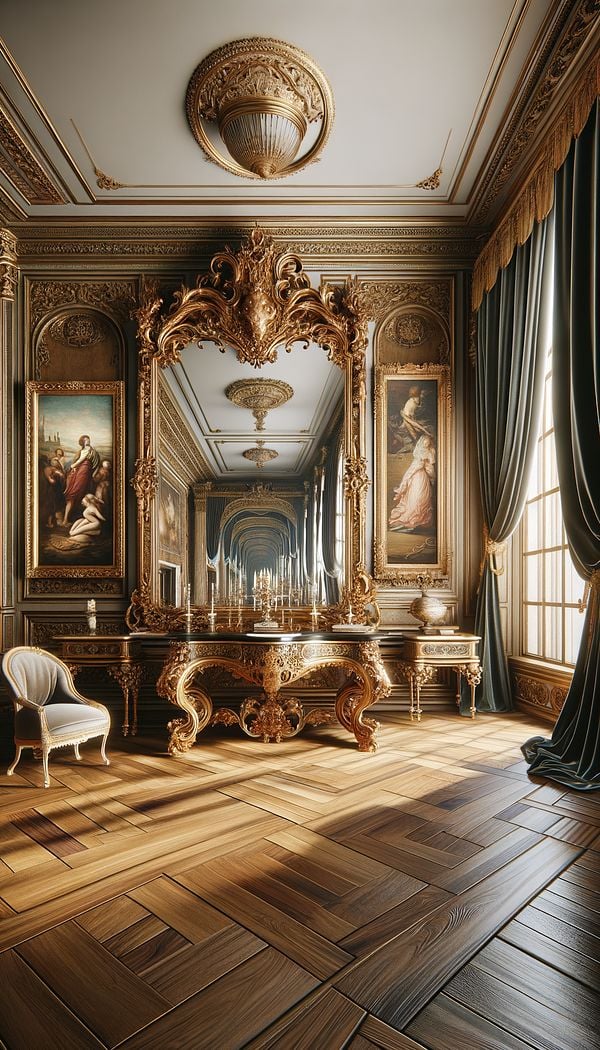What is French Renaissance?
French Renaissance refers to a period of rebirth in French art and architecture, emulating classical forms with a focus on symmetry and proportion.
Description
The French Renaissance, an awe-inspiring era in the world of interior design and architecture, marked a period of great cultural rebirth and flourished from the late 15th century to the early 17th century. Rooted in the Italian Renaissance, it brought to France the revival of classical Greek and Roman art, blended with the nation's distinctive Gothic traditions. The movement saw the introduction of new construction techniques, innovative uses of materials, and a keen emphasis on decorative details, altogether setting the stage for a transformative era in European architecture and design.
The hallmarks of French Renaissance interior design include the use of intricate patterns, lavish decoration, and the adoption of architectural elements such as columns, pilasters, and pediments. Interiors were characterized by their elegance and harmony, meticulously balancing the grandeur of Renaissance Italy with the subtlety of French artistic sensibilities. Ornamental motifs often featured foliage, fruits, and emblematic figures, incorporated into furniture, tapestries, and murals to evoke a sense of opulence and sophistication.
Over time, the French Renaissance evolved to incorporate more elements of humanism, reflected in a greater emphasis on comfort, functionality, and the personalization of space. Despite the flamboyance, there existed a practical side to the design philosophy, paving the way for the development of more domesticated spaces that catered to the changing needs of the society.
Usage
Today, French Renaissance interior design influences can be seen in spaces that seek to combine classic elegance with luxury. Ornate furniture, elaborate wall décor, and luxurious textiles often tribute the era, blending seamlessly with modern amenities for a timeless and sophisticated aesthetic. Historic buildings restored to their former glory or new constructions aiming to capture the essence of the French Renaissance period often incorporate elements like detailed woodwork, sumptuous fabrics, and meticulously crafted decorative objects.
FAQs
-
How is French Renaissance design different from Italian Renaissance?
While both movements sought inspiration from the classical past, French Renaissance design is distinguished by its blend of Italian Renaissance elements with France's Gothic tradition, a greater emphasis on detail, and the subtlety in the balance between opulence and elegance. Italian Renaissance, in contrast, often showcased more austere sophistication with a stronger focus on proportion and perspective.
-
What kind of materials were commonly used in French Renaissance design?
Materials commonly used during the French Renaissance included stone and wood for structure, with luxurious fabrics such as velvet and silk for textiles. Decorative elements often featured metals such as gold and silver, alongside glass and ceramics for ornate details.
-
Can French Renaissance styles be incorporated into modern homes?
Yes, elements of French Renaissance can beautifully complement modern interior design. Incorporating ornate furniture pieces, elaborate tapestries or wall décor, and detailed architectural elements can lend a grand and sophisticated air to contemporary spaces, merging the timeless elegance of the Renaissance with modern comfort and functionality.
Practical Application
To infuse French Renaissance charm into your space, start with key furniture pieces that epitomize the era's lavish craftsmanship, such as a gilded mirror or an intricately carved table. Combine these with luxurious textiles and a rich, earthy color palette to evoke the period’s opulence. Paying attention to detail, especially in architectural finishes and decorative objects, will help achieve a truly Renaissance-inspired ambience. Don't forget to balance the grandeur with modern elements for a sophisticated yet comfortable living space.
-
Architectural Elements199 articles
-
Design Styles478 articles
-
Furniture Types599 articles
-
Decorative Techniques322 articles
-
Materials & Textiles360 articles
-
FanlightA fanlight is a semi-circular or semi-elliptical window with glazing bars or tracery radiating out like a fan.
-
ContrastContrast is the difference in luminance or color that makes an object distinguishable.
-
Arm ChairAn arm chair is a chair with supports on the sides for resting your arms.
-
JacquardJacquard is a fabric characterized by complex patterns woven directly into the material.
-
Full Grain LeatherFull grain leather is the highest quality of leather available.
